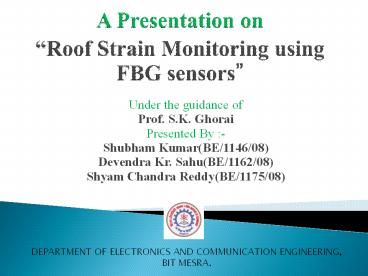Roof Health Monitoring using Fiber brag grating - PowerPoint PPT Presentation
Title: Roof Health Monitoring using Fiber brag grating
1
A Presentation on Roof Strain Monitoring using
FBG sensors
- Under the guidance of
- Prof. S.K. Ghorai
- Presented By -
- Shubham Kumar(BE/1146/08)
- Devendra Kr. Sahu(BE/1162/08)
- Shyam Chandra Reddy(BE/1175/08)
DEPARTMENT OF ELECTRONICS AND COMMUNICATION
ENGINEERING, BIT MESRA.
2
What is fiber grating ?
- A periodic perturbation of the refractive index
along the fiber length which is formed by
exposure of the core to an intense optical
interference pattern.
3
Schematic diagram of structure and spectral
response of ?ber Bragg grating
4
Broadly classified into two types
- Bragg Gratings
- Transmission gratings
- Coupling occurs between modes travelling in
opposite directions
- Coupling occurs between modes travelling in the
same direction.
5
How does FBG work?
- To understand why waves re?ected o? two
successive interfaces are in phase at the Bragg
wavelength, represent the wave interacting with
one small part of the ?bre like this.
6
That part of the incident beam that travels along
the path ABA , has travelled an extra path length
of ?/2. Its phase has changed by p. For that
part of the beam which travels along ACA , the
path length is ?, which corresponds to a phase
change of 2p. But it has also su?ered a re?ection
at a low-to-high interface. Hence The total phase
change is 3p, and the phase di?erence between the
two parts of the beam is ?f fACA - fABA 2p
Hence the two parts of the re?ected wave are in
phase with one another a result which relies on
the fact that the wavelength is equal to 2d.
7
Types of Grating
8
Fundamental Transfer Matrix Approach
- Grating structure is discretized as a cascade of
N uniform subgratings , each having a specific
period ? , phase offset Ø and modulation depth
?n.
A grating may be approximated by a number of
subgratings (a), each having a speci?c period ?,
phase f and modulation depth ?n. In (b) a single
subgrating of length l is shown.
9
Reflectivity Vs Normalised Wavelength for a FBG
10
Effect of variation of ?n on reflectivity
11
(No Transcript)
12
Our Model
13
FBG Setup
Inset Picture FBG used.
14
Our Experimental Setup
Y-coupler
Broadband source
Prototype of the mine
Optical spectrum analyzer (OSA)
15
Spectrum of Broadband Source
16
Finding of Zero Error (at 0 gm load condition)
17
Spectra obtained for 200gm weight
18
How to find strain developed in roof from the
loads
Strain equation I (bd3 )/3(moment of
inertia of rectangle about its base)
Strain w y (L/2) 4E
I Where yProportionality constant EElasticity
3400 Mpa for Thermocole
(polystyrene) LLateral length44.5cm bbreadth
23.2cm ddepth1.8cm wweight
19
Weight to strain conversion
Sr.no Weight (gm.) Strain (10(-3)) Wavelength(nm)
1 0 0 1552.100
2 50 74 1552.160
3 100 148 1552.220
4 150 222 1552.280
5 200 296 1552.340
6 150 222 1552.220
7 100 148 1552.100
8 50 74 1552.040
9 200 296 1552.340
20
Fiber Grating Sensor Array with Phase-Sensitive
Detection
21
Requirements
- 1. Broadband source.
- 2. Pulse Modulator.
- 3.A fiber Mach-Zehnder (MZ) Interferometer.
- 4. TDM Demux
- 4. BPF
22
How the system works ?
23
(No Transcript)
24
(No Transcript)
25
What we have done till now ?
- Dependence of wavelength shift on the strain
applied in FBG and calibration between them. - Complete step-by-step MATLAB simulation of the
model discussed to monitor strain in roofs of
various structure.
26
Setup for modulating source pulse
27
(No Transcript)
28
Fast Fourier transform is applied to the output
intensity of the interferometer to get the
electrical spectrum which has characteristics
similar to that of the input wavelength spectrum
The Output of the Interferometer is passed
through DEMUX to separate out different channels
which is then passed through BPF to get output
signal depending on the strain applied.
29
Phase dependence on strain is given
as ??(2pnd/?)??e where ? (1/?
)(d?/de)0.74ppm/µ? d 1mm,n1.46
30
(No Transcript)
31
CONCLUSION
The thorough investigation of how strain can be
measured using fiber bragg grating sensors is
done. The Grating Sensor Array with
Phase-Sensitive Detection model was simulated
using MATLAB and code segments for different
segments were executed. Proper calibration is
done for mapping strain against corresponding
wavelength shifts in FBG Via implementation on
the designed experimental setup. Different
Interrogation techniques available were
analysized but finally interrogation was done
using an unbalanced MZ interferometer The
highlights of this project are 1. Relation
between strain and bragg wavelength shift is
derived and proper calibration between them is
obtained. 2. A model system was developed to
monitor strain developed in the roofs of various
structures. 3. Complete software analysis of
proposed model is implemented using MATLAB.
32
FURTURE Scope
Further work is possible by doing a complete
hardware implementation of the same model and
making a working system exactly based on the
coding done. Proper data acquisition system has
to be developed to support real-time monitoring
of structures roof.
33
REFERENCES
1. Y. J. Rao, In-fiber Bragg grating sensors,
Meas. Sci. Technol., vol 8.
2. U. Kenneth and G. Meltz, "Fiber Bragg Grating
Technology Fundamentals and Overview," IEEE
Journal of Lightwave Technology, vol. 19, no 10,
1997.
3. R. S. Weis, Member, IEEE, A. D. Kersey, and T.
A. Berkoff A Four-Element Fiber Grating Sensor
Array with Phase-Sensitive Detection IEEE
PHOTONICS TECHNOLOGY LETTERS, VOL. 6, NO. 12,
DECEMBER 1994
4. A. D. Kersey, T. A. Berkoff, and W. W. Morey,
Fiber-grating based strain sensor with phase
sensitive detection,
34
Thanking you.
Presented byG. Shyam Chandra ReddyDevendra
Kumar Sahu Shubham Kumar































